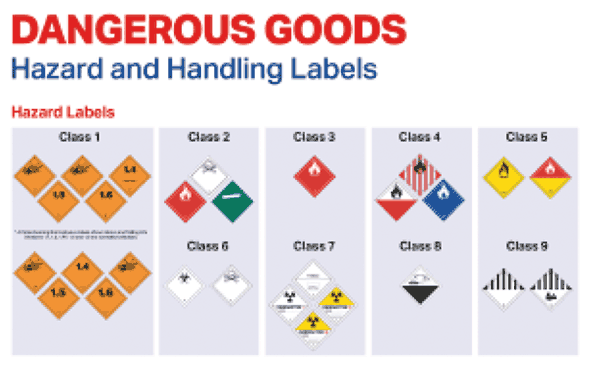|
An old hand in the air cargo business, Radharamanan
Panicker, has seen it all, done it all. One of the country’s well-known
air freight specialists, he managed Cargo Service Center India (CSC) for
around 20 years. In his time, the company grew from a single station set-up
into a multi-airline handling company with stations in Mumbai, Chennai
and Delhi. The company also got the contract for construction and management
of the Perishable Cargo Terminal in Mumbai and the Second Integrated Cargo
Terminal in Delhi. In 2014, Panicker decided to go out on his own and
formed his own company: Dangerous Goods Management (DGM) India. DGM India
is a fully recognized dangerous goods training entity in the Indian air
cargo market and Panicker is possibly one of the few experts in dangerous
goods in the country. No wonder, it is difficult to pin him down –
at least 15-20 days in a month, Panicker is somewhere in the country training
people in how to handle Dangerous Goods.
Danger Zone & No Panic Panicker
ACNFT met Panicker to find out
how the pandemic had treated the Dangerous Goods business. “Dangerous
goods movement by air is very limited. This is also because many do not
carry dangerous goods for the fear that the shipper is not competently
doing the job of making the transport of dangerous goods safe. They fear
the proper declaration of the DG cargo in terms of their proper shipping
and classification including packing group (this indicates degree of danger).
So, the cost of transporting DG goes up much higher as compared to general
cargo, whereas there is no extra or special service provided by the airlines.”
Panicker said that the lack of sufficiently and
efficiently trained staff was missing from the airline and their GHS.
“To make matters worse, airlines have different standards on acceptance
of DG by the airlines—often at variation with what is stated in
the regulation. X Airlines accepting DG at Mumbai and Ahmedabad or Delhi,
will have different methods or procedure for acceptance of DG cargo.
“Finally, the big challenge is the
way DG packages are examined in India.”
 |
Dangerous Goods handling then was a business,
necessitating know how and strict controls. From packaging and labelling
to compliance and infrastructure, the smallest of errors can result in
the biggest of catastrophes. Panicker agreed: “The fundamental idea
behind safe transportation of dangerous good, whether by air, ocean or
other surface mode, is that the Regulation is strictly followed. This
involves correct identification of the substance by their proper shipping
name and UN number, proper hazard classification of the substance, packing
them in accordance with the requirement given in the regulation, communicating
the hazard contained in the package through marking and labelling of packages
on one hand and placarding of tanks and containers, trucks and rail wagon
on the other hand and finally documenting these substances. In essence
all these are the responsibility of the shipper.”
The critical area in understanding is the
classification and identification of the dangerous goods. While some substances
are known because they are already identified by the UN Committee of Expert,
the nodal body of experts, there are many others (derivatives, solutions
or mixtures) which needs to be classified first before arriving at their
identification by UN number and proper shipping name. This is a critical
function, which is often neglected.
“Obviously, it all means that everyone
involved in the transportation of such goods must be thoroughly trained
in the regulation. The level of training depends on the function the person
is carrying out or likely to carry out,” said Panicker.
Another important aspect is packaging. Appropriate
packaging here means that every package that is to be used for packing
and transporting dangerous goods must be made using the material and quality
in accordance with the requirements given in the regulations. Once that
is done, these packages need to be tested and certified for use in packing
dangerous goods substances or article. And therein lies the biggest challenge.
The trade cuts corners to save a few rupees here and there, but that means
risking not only the supply chain but also the life of people.
For safety, then, could technology help?
The DG expert commented “the role of technology has not yet been
fully explored or used. However, there are information systems available
and being used for processing of dangerous goods documentation and communicating
electronically with the logistics participants such as shipping lines
and airlines. But it is not actively implemented.”
Another area where technology could be used,
especially internet of things, is in the manufacturing of packages for
shipping dangerous goods and its testing by certified and authorized labs.
Some time ago, a leading air cargo DG expert
described the threat to air cargo from unidentified and unlabelled hazardous
materials in shipments resulting from online auction sales and retail
sites. He described that as “the Wild West of Dangerous Goods”.
Despite outreach from bodies like IATA, there have been breaches. With
fines being small, change has been slow in coming. Panicker said that
the “biggest danger or risk to an airline is from what we call hidden
dangerous goods or undeclared dangerous. Many exporters are generally
traders and they don’t understand the technicalities of the chemical
or such product which may be inherently dangerous. They fail to recognize
them. Sometimes there are some unscrupulous freight forwarders, who also
advise their customers incorrectly and motivate them to take chances.”
He pointed out: “What is also not known
is that India has a Regulation called Aircraft (Carriage of Dangerous
Goods) Rules 2003, which besides enabling the implementation of ICAO Technical
Instruction for Safe Transport of Dangerous Goods in India, lays down
the requirement for shippers and others to follow, including the need
for training.” Whether the aviation sector has enough enforcement
resources or not is something that the Directorate General of Civil Aviation
(DGCA) has to evaluate. “But, yes there is a need for surveillance
audit of all entity involved in the transport of DG by air in order to
bring a certain discipline.”
He said that the fines for violation of the dangerous
goods regulation were not small as far as air transport was concerned.
Last year, for example, the Government of India increased the fine from
INR100 million to INR1000 million and also possibly imprisonment extending
up to two years, under Section10 of the Aircraft Act 1934.
“The question that needs answering is how
many have been penalized for violating the Regulation?” Panicker
asked.
Tirthankar Ghosh
|




